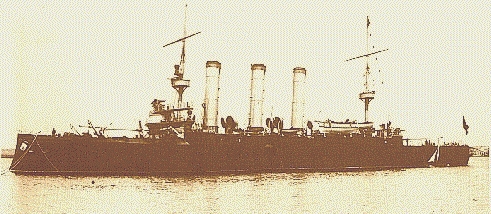


Background:
The CARLOS V was classified as 1st class battleship, according to Spanish naval classification, but was actually an armored cruiser. Her keel was laid in 1892 and the vessel was launched on March 12, 1895 at the Vega-Murguía Shipyards. The CARLOS V was the largest vessel built in the Spanish shipyards during the era leading up to the Spanish American War and her construction was made difficult by the variety of sources required for her various components. Her engines and boilers were Spanish, her armor was produced in Germany, stern and stern-post were produced in England, and her turrets were the products of France. By 1897 she was in El Havre, France, for the installation f her turrets.
On April, 1898, at the outbreak of the Spanish American War, she was not yet fully operational, but she was still included in Camara's Squadron. The CARLOS V was under the command of Captain D. José María Jiménez Franco.
On June 16, battleship PELAYO, cruiser CARLOS V and several auxiliary ships were sent to steam to Manila to counter the Americans in the wake of the Battle of Manila Bay/Cavite. When Camara's Squadron arrived at Port Said (Egypt), the Egyptian government delayed the supply of coal to the squadron. By the time the Squadron arrived at the Suez Canal (Egypt), the war was already effectively lost for the Spanish. An order was sent to Admiral Camara to return to Spain on July, 7. The squadron was dissolved on July 25.
After the War, the CARLOS V represented the Spanish Navy in several naval ceremonies in foreign countries, such as the coronation of King Edward VII of Great Britain in 1902.
CARLOS V remained in commission until 1922 and was finally dropped from the navy rolls in 1932.
Advantages/Disadvantages:
CARLOS V was a good vessel but her actual speed (16 knots) was well under her theoretical design speed of 20 knots. The armor on her sloping protective deck was inadequate. Her best characteristic was her great range.


| Classification | Battleship, 1st Class (actually armored cruiser) | |
|---|---|---|
| Launched: | March 12, 1895 | |
| Completed | Jun 2, 1898 | |
| Rig: | 2 masts | |
| Armament: | Two 280 mm (11 inch) guns | |
| Eight 140 (5.5 inch) guns | ||
| Four 100 mm (3.9 inch) guns | ||
| Two 70 mm (2.7 inch) guns | ||
| Two 55 mm (2.2 inch) guns | ||
| Six torpedo tubes | ||
| Contractor: | Vega-Murguia Shipyard (Cadiz, Spain) | |
| Length: | 116 meters (404 feet)t | |
| Beam: | 20.7 meters (67 feet) | |
| Draft: | 7.8 meters (25 feet) | |
| Displacement: | 9,235 tons | |
| Complement: | 590 men | |
| Engine Type: | Engines listed as generating 18.500 hp. | |
| Boiler Type: | ? | |
| Speed: | 20 knots (theoretical) 16 knots (actual) | |
| Coal bunker capacity: | 1,200 tons | |
| Weight of main guns: | 32.5 tons | |
| Coal Endurance: |
12,000 miles at 10 knots
|
|
| Armor: | Turrets - 250 mm (9.8 inches), decks/ sides - 62 mm (2.4 inches) | |
| Cost: | 18 million pesetas |
Martin Lopez J., Cruceros. (Madrid: Editorial San Martin S.L., 1976).